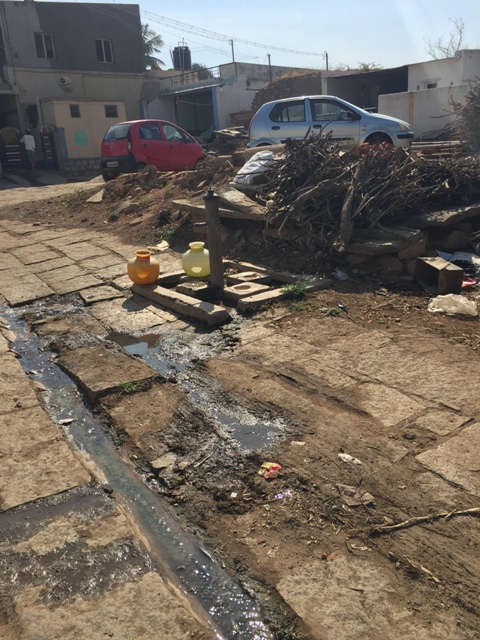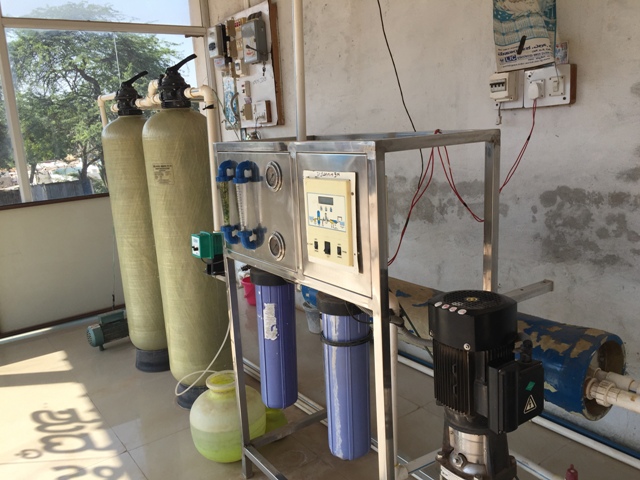 Hirehandigola village in Gadag district of North Karnataka is an unsurprising picture of rural India. Hot, dry and dusty, it is populated by a largely lingayat community. About half the village has household toilets, significantly higher than the district average of 24% as per the 2011 Census. At first glance, this village looked quite urbanised – a few cars, good Internet access, several of the younger people using Android phones. The open drain in the middle of the street winding through the village was an anomaly, in this context… or perhaps not, as this seems to be widespread across India, where our houses are spotlessly clean but dirt and filth lies strewn all around the house.
Hirehandigola village in Gadag district of North Karnataka is an unsurprising picture of rural India. Hot, dry and dusty, it is populated by a largely lingayat community. About half the village has household toilets, significantly higher than the district average of 24% as per the 2011 Census. At first glance, this village looked quite urbanised – a few cars, good Internet access, several of the younger people using Android phones. The open drain in the middle of the street winding through the village was an anomaly, in this context… or perhaps not, as this seems to be widespread across India, where our houses are spotlessly clean but dirt and filth lies strewn all around the house.
Most of the village belongs to the upper lingayat caste. Hirehandigola is also a revenue village for the Gram Panchayat (GP), which explained the visible signs of urbanisation and access to services. Walking through the village, it was striking that parts occupied by the Scheduled Castes appeared cleaner than those occupied by the upper castes. Caste is an all pervading filter to any conversation about community sanitation and hygiene, and historically in India, it is well known that there has always been a lower caste of people whose job it is to clean other people’s filth.
Prasanna came to Hirehandigola in 2014. As part of a fellowship run by an NGO called SCOPE, he was placed in Hirehandigola to apply the knowledge on water and sanitation that he had learned. He spent a year living in the village, working with the community to improve the water and sanitation conditions. Originally from the Udupi region of South Karnataka, Prasanna found it hard to understand and navigate his way around when he first started living there. However he gradually won the confidence of the village, by showing that he was genuinely interested in improving the sanitation situation in the village. He conducted a sample survey and learned about the problems of the village by taking the time to actually speak to people. Most of the community here was engaged in agriculture. This part of Karnataka is particularly dry, so during times of drought, many found themselves out of work. This invariably led to the vicious endless cycle of debt.
Building toilets for the village
The Gram Panchayat did not seem to be doing much in the way of water or sanitation for the village. Before Prasanna arrived, they never used to respond to the community's needs or requests. Prasanna worked hard to bridge the gap by facilitating subsidy payments to beneficiaries; he helped community members to fill forms, submitted them to the GP office and even helped to clear payment backlogs. He also screened videos and street plays in the village to spread awareness on the importance of sanitation.
 Prasanna’s main achievement during his time in Hirehandigola was the rejuvenation of a community toilet – 6 toilets shared by 12 families, kept under lock and key and used only by those families. All around the toilet, there was open space where others from the village defecated in the open. The community contributed to the construction of the toilet through shramadaan, the Gram Panchayat contributed Rs. 9000 in funds and SCOPE contributed Rs. 17000 to rejuvenate the community toilet. Before the rejuvenation, there was no pit or pan connection which is why it wasn’t being used. After the intervention, the toilet was evidently being used and looked quite clean.
Prasanna’s main achievement during his time in Hirehandigola was the rejuvenation of a community toilet – 6 toilets shared by 12 families, kept under lock and key and used only by those families. All around the toilet, there was open space where others from the village defecated in the open. The community contributed to the construction of the toilet through shramadaan, the Gram Panchayat contributed Rs. 9000 in funds and SCOPE contributed Rs. 17000 to rejuvenate the community toilet. Before the rejuvenation, there was no pit or pan connection which is why it wasn’t being used. After the intervention, the toilet was evidently being used and looked quite clean.
A school toilet in the village was also rejuvenated, and is now being maintained by the school. It had 4 urinals for boys and a water storage tank inside the boy’s toilet. One Indian toilet was for girls. The toilet was quite a distance from the school, but was locked and decently maintained.
What is sanitation without clean water?
 This part of the state of Karnataka gets about 630 mm of annual rainfall. There is an RO plant in the village, similar to many other villages in this region. With a treatment capacity for 1000 litres per hour, which could serve 150 families, it was installed by the GP to purify water from the tubewells in the village, some of which went as deep as 150 to 200 feet. These RO plants were envisioned as a one-size-fits-all solution to water quality issues that invariably arise when groundwater is extracted from deeper beneath the earth’s surface. Interestingly and not surprisingly, the RO plant was not being used in Hirehandigola; a testimony to the fact that when the community has little or no ownership over such an asset, it is likely to fall into disrepair.
This part of the state of Karnataka gets about 630 mm of annual rainfall. There is an RO plant in the village, similar to many other villages in this region. With a treatment capacity for 1000 litres per hour, which could serve 150 families, it was installed by the GP to purify water from the tubewells in the village, some of which went as deep as 150 to 200 feet. These RO plants were envisioned as a one-size-fits-all solution to water quality issues that invariably arise when groundwater is extracted from deeper beneath the earth’s surface. Interestingly and not surprisingly, the RO plant was not being used in Hirehandigola; a testimony to the fact that when the community has little or no ownership over such an asset, it is likely to fall into disrepair.
Hirehandigola is more or less representative of North Karnataka, and like other parts of the state and country as well, where government money is allocated for these kinds of rural water supply schemes. The GP digs 4 to 5 borewells and connects these borewells to a piped water supply system that provides water to households through taps. There is either one tap per household or one tap for every 5-6 houses. However the long term sustainability of such schemes is debatable. Copying urban approaches to water supply does not seem to work the same way in rural India, where operation and maintenance is difficult to sustain.
India Water Portal would like to thank Prasanna and the team at SCOPE, for showing us around Hirehandigola and other villages in North Karnataka.













